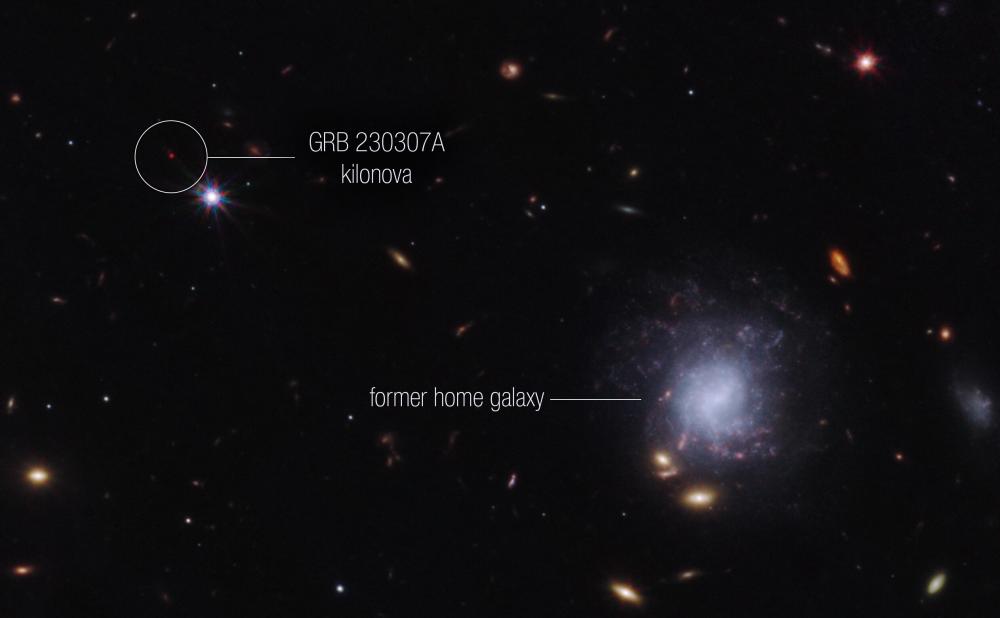
This image from the Near-Infrared Camera (NIRCam) instrument on NASA's James Webb Space Telescope highlights gamma-ray burst (GRB) 230307A and its associated kilonova, as well as its ancient parent galaxy. The neutron stars were probably expelled from their original galaxy and traveled a distance of around 120,000 light-years, roughly the diameter of the Milky Way, before merging several hundred million years later to form the GRB230307A burst. Credits: Image: NASA, ESA, CSA, A. Levan (Radboud University).
An international team of scientists, including a researcher from Irfu's Astrophysics Department, used several space and ground-based telescopes, including the James Webb Space Telescope and the European Southern Observatory's Very Large Telescope, to observe an exceptionally bright gamma-ray burst detected on March 7, 2023, GRB 230307A, and identify the neutron star merger that generated the explosion responsible for the burst. In particular, the Webb telescope enabled scientists to detect the chemical element tellurium in the aftermath of the explosion. This discovery supports the hypothesis that neutron star mergers are one of the main sources of production and expulsion into the interstellar medium of some of the heaviest elements known in the Universe.
These results were published in Nature on October 25, 2023 (Levan et al.).Heavy element production in a compact object merger observed by JWST | Nature
While neutron star mergers have long been theorized as the ideal pressure cooker for creating some of the rarest and heaviest elements known today, astronomers have so far encountered a number of obstacles in obtaining solid evidence. Short gamma-ray bursts (traditionally considered as those lasting less than two seconds) and kilonovae, which are generally attributed to the explosion produced by these mergers of compact stars, are extremely rare phenomena, making them difficult to observe. In this context, the case of GRB 230307A is particularly noteworthy. First detected by NASA's Fermi space telescope on March 7, 2023, it is the second-brightest GRB observed (after GRB 221009A) in over 50 years of observations, about 1,000 times brighter than a typical gamma-ray burst observed by Fermi. And despite its origin clearly associated with the merger of two neutron stars, its gamma-ray emission lasted around 200 seconds, placing it firmly in the category of "long" bursts generally attributed to other physical mechanisms (such as the collapse of massive stars). Its unusual characteristics immediately caught the attention of researchers, who set out to better understand the properties of this phenomenon.

This graphic presentation compares the spectral data of the GRB230307A kilonova observed by the James Webb Space Telescope with a model representing this type of phenomenon. Both the data and the model show a distinct peak in the wavelength band associated with tellurium (red shaded area). The detection of tellurium, which is rarer than platinum on Earth, represents a major advance in our understanding of these explosive phenomena. Credits & Illustration: NASA, ESA, CSA, Joseph Olmsted (STScI)
The collaboration of numerous telescopes on the ground and in space enabled scientists to gather a wealth of information on this event from the moment the explosion was first detected. After the explosion, an intensive series of observations was carried out to locate the source in the sky and track its brightness. These observations in gamma rays, X-rays, optics, infrared and radio showed that the optical/infrared counterpart was of low intensity and evolved rapidly over time, passing from blue to red with all the characteristics of a kilonova. The spectrum of the source obtained with the James Webb telescope also features broad lines showing that the material is ejected at high speed, with a very clear signature: the presence of tellurium, an element rarer than platinum on Earth.
Webb's highly sensitive infrared capabilities also helped scientists to identify the "cosmic address" of the two neutron stars that created the kilonova: a spiral galaxy around 120,000 light-years from the site where the merger took place. In the past, these were two normal massive stars, forming a binary system in their original spiral galaxy. At the end of their respective lives, these 2 stars died independently of each other, exploding as a supernova and leaving behind a neutron star. But as this duo was initially gravitationally linked, the binary system was propelled into space by these two separate events and expelled from its home galaxy. It traveled roughly the equivalent of the Milky Way's diameter before merging several hundred million years later, forming the March 7 burst and its kilonova.
Scientists expect to find more kilonovae in the future, thanks in particular to the ever-increasing possibilities for space- and ground-based telescopes to work in complementary ways to study variable phenomena in the Universe. This context will be enriched from spring 2024 by the Chinese-French SVOM mission, supported by Irfu, which will be dedicated to the detection, localization and study of gamma-ray bursts.
Contact IRFU/Dap: Emeric LE FLOC'H
NASA news: Webb's first detection of heavy element from star merger
• Structure and evolution of the Universe
• Department of Astrophysics (DAp) // UMR AIM
• Cosmology and Galaxy Evolution group (LCEG)
• JWST



